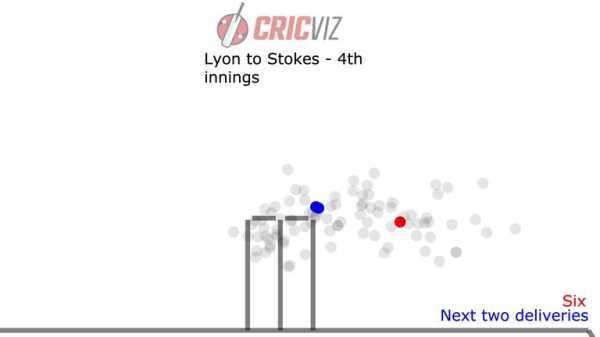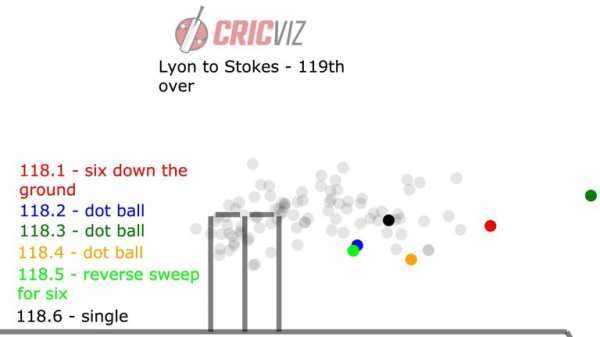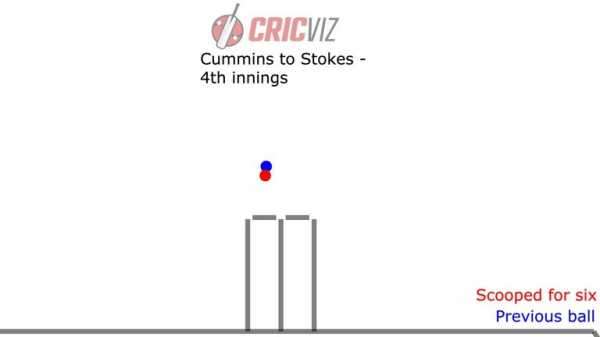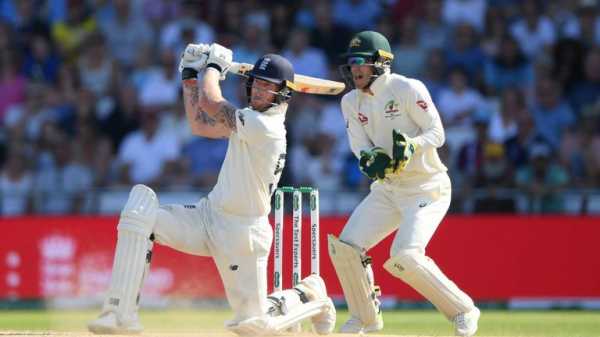
8:00
Highlights from day four of the third Ashes Test at Headingley in 2019 as Ben Stokes led England to a remarkable victory
An incredible innings on an unforgettable day. CricViz’s Patrick Noone reflects on Ben Stokes’ Headingley heroics of 2019 with contributions from Mike Atherton, Nasser Hussain and Isa Guha…
Pressure. Players are routinely judged on how they deal with it, whether they rise to the challenge or fail to overcome it.
One cricketer whose career has come to be more or less defined by retaining his clarity of thought in high-pressure moments is Ben Stokes. And across two balmy Leeds days in August 2019, with the Ashes on the line, he held his nerve in the pressure cooker of Headingley to play one of the most extraordinary innings ever witnessed in Test cricket.

3:23 Stokes’ match-winning four at Headingley was an amazing moment, whichever angle you watch it from
Chasing 359 in the fourth innings having been bowled out for 67 first time around, England’s chances could have been generously described as minimal. According to WinViz at the start of the innings, they had just an 11 per cent chance of pulling off their highest-ever successful run chase.
Stokes himself had been guilty of a poor dismissal in England’s first innings. Only once has he been out to a wider ball in Test cricket than the one James Pattinson served up on day two. Stokes reached for it, edged to slip and departed for eight to leave England 34-4.

By the time Stokes arrived at the crease in England’s second innings, Joe Root and Joe Denly had at least given him a platform upon which to build. With the score 141-3, England’s WinViz had doubled to 22 per cent from the start of the chase and so began something remarkable.
Stokes started slowly, registering 30 dot balls between the first and second singles of his innings and he reached stumps on day three with just two runs to his name from 50 balls faced. Never before in his Test career has Stokes scored so few runs after facing so many balls. He only attacked two of those first 50 balls, such was his determination to not repeat the mistake of the first innings.

Stokes’ approach was not totally out of the blue. His defensive technique had been on an upward curve for the last few years and he had become a far more complete batsman than the one who struck the fastest hundred at Lord’s in 2015 and the fastest double hundred in Test history at Cape Town a year later. Nonetheless, for a player associated with those explosive innings, this began as a performance from the other extreme of his skillset.
With England needing 203 more runs at the start of day four, WinViz was now giving them a puncher’s chance at 29 per cent, but, as the day progressed, Stokes was running out of partners with only Jonny Bairstow offering any serious resistance to Australia’s inexorable march towards retaining the Ashes at the earliest opportunity.
Bairstow’s departure for 36 just after lunch led to a mini collapse that saw Jos Buttler and Chris Woakes each dismissed for one. Jofra Archer hung around a little longer to make 15, but after his dismissal was shortly followed by Stuart Broad’s two-ball duck, Stokes was left with just Jack Leach for company.
By now, Stokes had made his way to 61 from 174 balls. The obduracy he had shown the day before continued after he resumed on day four as he failed to score off any of the first 10 deliveries he faced. But after that, his run-rate rose to a consistent level throughout the day as he began to dictate terms against Australia’s bowlers.
Ben Stokes v Australia, 4th innings – Run rate progression up to Broad wicket
| Balls faced | Run-rate |
|---|---|
| 0-30 | 0.20 |
| 31-60 | 0.20 |
| 61-90 | 3.00 |
| 91-120 | 3.00 |
| 121-150 | 3.40 |
| 151-180 | 3.80 |
With Leach the last man standing and with 73 runs still needed for victory, Stokes was going to have to change gears if he was to get his side over the line. England’s WinViz had plummeted to six per cent and it appeared there would be no way back for them.
On the Sky Sports coverage of the match, Mike Atherton’s voice is relaxed as Leach comes to the crease, as though he is expecting to calmly read the last rites to England’s Ashes campaign. The other notable aspect of Atherton’s commentary is that, for the first minute or so after Leach reaches the middle, there is seemingly nobody commentating alongside him.
- Heroic Stokes seals unforgettable win
- Willis: Victory eclipses miracle of 1981
- Botham: Stokes is the Special One
Isa Guha should have been Atherton’s co-commentator at that stage, but she made the decision to step aside to allow an Australian to describe the winning moment that everyone assumed would be imminent. Atherton remembers how it transpired that Shane Warne joined him on commentary unexpectedly.
“I should have been on with Isa and she took herself off commentary and said, ‘we should have an Australian voice on here’, and that’s when Shane came in.
“I thought that was a nice move from her. I think it was right that there was an Australian voice on at that point.
“In the same way that Bumble in that World T20 Final [in 2016] allowed Ian Bishop to call the last moment, I think they’re nice things when a commentator recognises that it’s not just about them.”
It is certainly not a decision that Guha regrets, even with the hindsight of knowing what was about to happen.

0:30 Stokes says the ovation he received after leading England to victory is a moment that will live long in the memory
“I just honestly believed that if I’d stayed there for another delivery the game might have ended, so it was definitely the right thing to put an Aussie on commentary, especially when you’ve got the choice of Shane Warne or Ricky Ponting.
“I would never forgive myself for not doing that. If that game had ended the next ball and I was still on commentary, it just wouldn’t have been the right thing at all. Especially given that Australia would have retained the Ashes at that point.”
Back out in the middle, Leach successfully negotiated four balls from Pattinson to bring Stokes back on strike against Nathan Lyon.
Until that point, Stokes had only attacked four of the 73 deliveries he had faced from the off-spinner, but his tactics were about to change dramatically. Immediately there was intent in the first two shots he played off Lyon’s over – a cut shot that he failed to connect with and a reverse sweep that dribbled harmlessly off a combination of inside edge and body onto the ground.
- Sensational Stokes – how Twitter reacted
- ‘One of the great days’: Ashes Watchalong
Two balls later he got it right, striking Lyon firmly over long-off for six. The cheer from the crowd was almost ironic at that stage; they were going to have a bit of fun watching Stokes tee off, but with England still needing 67 to win, any thoughts of victory were still at the back of most people’s minds.
However, in the Sky Sports commentary box, Nasser Hussain was not so sure that the match was quite over yet.
“I think it was Isa who said to me something like ‘this is a shame, this is nearly done isn’t it?’ and I said, ‘well, you never know with Stokes’. While he was there, there was always a chance.”
Lyon’s response to Stokes’ six was to go straighter and cramp the left-hander for room with the last two balls of the over. That bucked a trend that generally saw Lyon push the ball wider to Stokes after the fall of the ninth wicket, a tactic that led to one of the most astonishing moments in the innings.

Oh, what a shot that is!
The first ball of Lyon’s next over was wide enough that Stokes had to step in front of his stumps and launch another straight six. Lyon responded first by going a touch straighter but then bowling the widest ball he would bowl in the innings. Deliberate tactics or pressure starting to tell on the world’s number one spinner in red ball cricket?

After another dot ball in Stokes’ fourth stump channel, the fifth ball of the over was the moment that everything started to change.
From a ball almost identical in line and length to the one Lyon bowled three balls before that was hit to mid-on, Stokes instead readjusted and dispatched a remarkable reverse sweep into the Western Terrace. For the first time, the crowd noises are unironic and for the first time, Atherton’s voice rises with them.
“At that point, England needed 50 to win and you could sense a bit of a shift in the atmosphere, a bit of a shift in the momentum,” he recalls. “Suddenly Australia had everyone back on the boundary. You sensed a bit of panic in their ranks.
“In that particular shot, what I do remember is that Lyon was bowling very wide to Stokes basically trying to keep Leach at that end.
“He was bowling very negatively at the end of that over and I can remember thinking to myself, ‘well, the reverse hit or the switch hit is on here’, but I can also remember thinking to myself, ‘they’ve got people back on the boundary’ and I knew that I wouldn’t have had the balls to take it on.
“So, the note of surprise in my voice is not surprise that he’d taken that option, in that I sensed that it was on. It was more the fact he had the balls to go through with it, as it were.”

Perhaps Stokes was able to find that courage from the experience he had of dragging England out of a hole just six weeks earlier, in the World Cup Final.
“Having had the World Cup final a few weeks before – the feelings and mindset associated with that were so fresh in his mind,” says Guha.
“To play the reverse-sweep when he did – that was experience and clarity of thought all coming together for him to believe it was the only shot he should play in that moment. There were no doubts creeping into his head whatsoever.”
As eye-catching as the shot was, arguably the most important aspect was that Stokes had succeeded in hitting Lyon out of the attack, temporarily at least. The man who had spun Australia to victory at Edgbaston just two Tests ago was now unable to be called upon by his captain on a wearing pitch in the fourth innings of a crucial Ashes Test.
After Leach saw out four balls from Pattinson in the next over, Pat Cummins replaced Lyon at the Kirkstall Lane End. On the second ball of the over, Stokes attempted an audacious scoop shot, but failed to get bat on ball. Undeterred, he played the same shot the next ball – an almost identical delivery – this time connecting and sending the ball over the fine leg boundary for another outrageous six.

Stokes evidently had assessed that the scoop was the right shot to play to that delivery, and the fact he hadn’t executed it correctly first time around was irrelevant. To maintain the clarity of thought to recognise that in that situation is remarkable in itself; to have the skill to pull the shot off as well is almost unique.
You don’t need me to tell you what happened there, just listen to the crowd
The reverse sweep off Lyon was followed by a scampered single that had been met with a standing ovation from the Headingley crowd. The scoop off Cummins was greeted similarly. By now, there was a real sense in the ground that England could do the unthinkable. Atherton remembers how the atmosphere contributed to his commentary that day.
“It’s much easier when there’s an atmosphere like that, you’re just carried along with it,” he says.
“What it allows you to do actually is just occasionally play off the crowd. Sometimes you don’t need to say anything because it’s obvious from the crowd’s reaction what’s happening and you can just, in a very gentle way, play off that.”
That sentiment was never more evident than at the end of Cummins’ over when Leach dead-batted a full delivery that needed no description beyond the roar that greeted it from the stands.
It was to be the last ball of Atherton’s commentary stint as he and Warne were replaced by Hussain and Ponting for the final act of the drama, with England needing 37 to win and Stokes four runs away from his hundred.
Up in the air again. Western Terrace again! SIX AGAIN!
It was something of a baptism of fire for the commentary pair as Stokes immediately swatted a four off Josh Hazlewood to reach three figures, before hitting successive sixes that were gratefully received by a delirious Western Terrace. Hussain remembers what it was like to come on at such a pivotal juncture.
“There was so much energy in the box by then that it was easy to come on at that stage,” he says.
“It’s not calling the fours or sixes that’s hard, it’s as the ball’s up in the air. Some of them were just creeping over and the challenge is to call it right. Not only could it be six and Western Terrace again, but it could also be Australia retain the Ashes.
“Every ball had something on it.”

Stokes was then able to take an easy single from the fifth ball, giving Leach just one delivery from Hazlewood, and Tim Paine’s side were beginning to buckle under the pressure. As Hussain recalls, the combination of Stokes and the crowd was causing Australia to lose the plot.
“I think Australia got their tactics horribly wrong but with the reaction of the crowd that day, you can understand why Tim Paine’s brain got completely scrambled because he couldn’t believe what was happening in front of his eyes,” he says.
“Really modern cricketers, which Stokes is, can suddenly go into this T20 mode and you can see oppositions just unravel in front of you.”
Paine’s response was to bring Lyon back into the attack and, after Stokes took him for one off the over, Cummins returned to replace Hazlewood. The first ball of Cummins’ over was Stokes’ first major let off as a skewed drive carried to Marcus Harris at third man, but he was unable to hold on.
Stokes followed up that narrow escape with a four through mid-wicket and a dismissive pull-cum-drive – arguably the shot of the innings – that whistled past Cummins to the long-off boundary, beating a despairing Hazlewood.
The nerves and pressure were not just being felt out in the middle, but in the commentary box as well, as Ponting remarks that Hussain’s microphone is shaking in his hand.
“That’s just me,” says Hussain. “Even Rooty [Joe Root] picks up on it when I do the toss. I have this nervous disposition, when I’m under pressure or a bit nervous I get the shakes a bit in my hands.”
Meanwhile, Guha was struggling to sit down and remembers the emotion of those crazy last few overs.
“It was edge of your seat, falling on the floor, heart pumping, literally coming out of our bodies because it was just that nerve-wracking.”

But with just nine runs to win, one man remained calm in the eye of the storm. Calling upon all the memories he had as a cricketer, Stokes was somehow able to focus his mind while others were losing theirs.
He took a single off Cummins’ next ball and gave Leach two balls to see out at the end of the over, the second of which struck him on the pad after pitching outside leg-stump and led to the ill-fated DRS review from Paine – more pressure.
The end of the over meant that Stokes would resume hostilities with Lyon. From the back of the Sky Sports commentary box, Atherton implored the off-spinner to toss it up and tempt Stokes into a big shot.
“One of the beautiful things about being sat in the commentary box is that you have no responsibility, there’s nothing on you at all,” enthuses Atherton. “You can make all these brilliant suggestions about declarations and field placings.
“All the kind of things that you see from a distance and there’s that clarity that comes to you, but obviously out in the middle it’s doubly difficult.”
Clarity of thought and lack of responsibility were certainly not luxuries Lyon could afford, however toss it up was exactly what he did with the third ball of the over, landing it 3.4m from Stokes’ stumps. It was right in the slot and Stokes took it on, clearing the long-off boundary again. Two to win.
More drama would follow in the over as Stokes played a reverse sweep off the penultimate ball. With victory so close, possibly the first chink in Stokes’ temperament was exposed as he set off for a single that wasn’t there, hesitated and sent Leach – already two-thirds down the pitch – back to the non-striker’s end. The throw was accurate, all Lyon had to do was gather the ball and run out Leach by several metres.
It was the kind of regulation take he must have made thousands of times in training, in state matches, even in Test matches at less pivotal moments than now. But pressure does funny things to people, and Lyon inexplicably fumbled.

To leave Lyon with an even more bitter taste in the mouth, his final delivery trapped Stokes on the pad, but umpire Joel Wilson waved the appeal away. The replay showed the ball would have hit the stumps and Stokes would have been out had Australia had a review up their sleeve.
And so, it was left to Leach, England’s No 11, to face Cummins, the No 1-ranked bowler in Test cricket. After ducking under a bouncer, Leach worked the ball to square leg but could not beat the infield. The very next ball, after Cummins had come around the wicket, he played the same shot, but this time was able to run through for the most important single of his career.
Cut away, cut away for four
Now Australia could not win the match, Stokes was on strike and Nasser Hussain was ready to call the winning moment.
“In such a great game and on such a great occasion, you just don’t want to end it by stumbling over your words,” he says. “It’s not planned, but you know that there are certain things you’ve got to get right.
“Ian Smith is not thinking ‘by the barest of margins’ before he calls it, Ian Bishop is not thinking ‘remember the name’, it just comes out naturally really.
“But with all those moments, I always am of the opinion, ‘don’t mess it up’. That’s the key, don’t mess up calling such a key moment.”

Hussain was in the unique position of being behind the microphone for both of the climaxes that defined England’s summer of 2019, having also commentated alongside Ian Smith and Ian Bishop during the final stint of the World Cup final six weeks before.
“I would say during the World Cup final, I was less nervous because I was working in between two masters in Bishop and Smith,” he says.
“So, I was sitting there in awe of what was going on in the middle but also in awe of the commentary of the two guys next to me.
“Smithy just led the show that day, so it was a bit easier, just sitting there watching a master at work and just adding to his commentary.
“But at Headingley, I was leading the commentary, so I was under a bit more pressure to get it right.”
With Australia all-but beaten, an exhausted Cummins served up a friendly delivery, short and wide outside Stokes’ off-stump, allowing him to hammer it to the boundary. The Headingley crowd erupted once more as Hussain declared ‘the Ashes well and truly alive because of one cricketer’.

5:31 Stokes played a remarkable innings to win the third Ashes Test for England and square the series
While England had been written off earlier in the day, Hussain had called it earlier than most that they still had a chance with Stokes at the crease.
“I think it helped me having been through it all with the World Cup a few weeks earlier, just in terms of remembering to not take this bloody game for granted,” he says.
“Sometimes commentators are surprised at what cricketers can do. The point of my comment that the match wasn’t over was that we shouldn’t be surprised that cricketers can do incredible things.”
Incredible things on an incredible day. As Stokes let out a guttural roar with both arms outstretched, basking in the release of the pressure built up over the course of 330 gruelling minutes at the crease, the crowd descended into bedlam and ecstasy, free at last from the unique tension that live sport can provide.
Sourse: skysports.com






